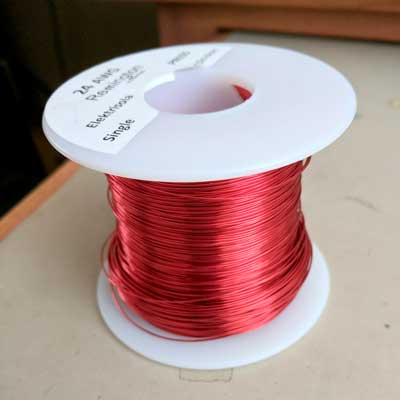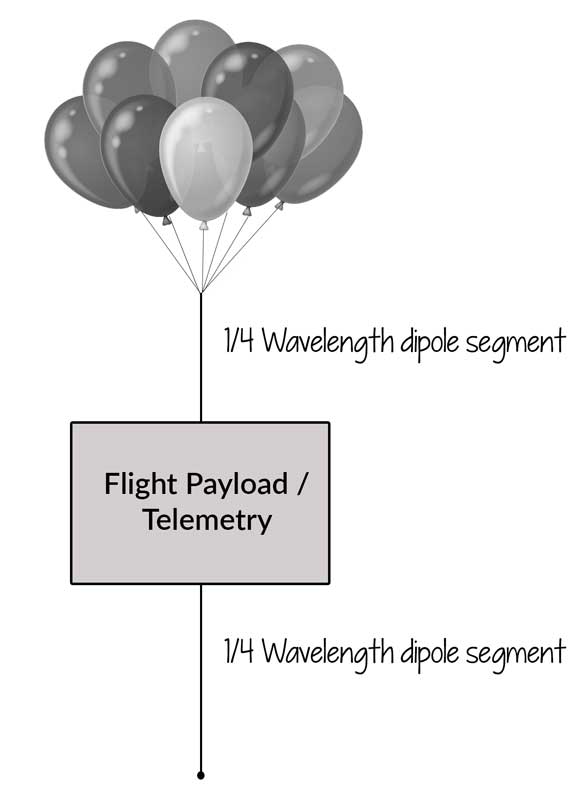Flying Squirrels #4 – Gettin it out there – The Antenna
 To get the telemetry signal on the air an antenna is needed. By necessity, the antenna must be light weight and simple. The size of an antenna is determined by the frequency we need the antenna to work at. The lower the frequency, the larger the antenna will be (There are exceptions to this rule but they require more complexity/weight). The Flying Squirrels will be using the 20 Meter ham band for telemetry, because it is a very popular band and will have the most WSPR stations listening.
To get the telemetry signal on the air an antenna is needed. By necessity, the antenna must be light weight and simple. The size of an antenna is determined by the frequency we need the antenna to work at. The lower the frequency, the larger the antenna will be (There are exceptions to this rule but they require more complexity/weight). The Flying Squirrels will be using the 20 Meter ham band for telemetry, because it is a very popular band and will have the most WSPR stations listening.
The ham bands are named according to their approximate wavelength, thus the 20 meter band has a wavelength of approximately 20 meters (~65 feet). Frequency and wavelength are just two different ways of measuring the period of a signal (sidebar). A given wavelength is equal to a certain frequency. The 20 Meter ham band is 14.000 – 14.350Mhz
Antennas size is directly related to the wavelength size and is typically multiples of quarter wavelengths in length. A quarter wavelength at 20 meters will be 5 Meters (16.4 ft). My tiny little balloon that has to loft a long antenna.
There are two antenna designs that can easily achieve my goals of being simple and light at multiples of 16 feet long. Yes, multiples, more than one 16ft length.
The Long wire antenna
I could use just a long piece of wire as the antenna. As well as being the antenna, the wire can be the “String” connecting the telemetry hardware to the balloon. Balloon -> Wire -> Payload. This type of antenna, is aptly called a Long Wire antenna. And to keep this discussion simple, this type of antenna needs to be about a full wave length long or longer. A minimum of 20 Meters in length. (Four – 5 meter Quarter-waves).
The Dipole antenna
The Dipole (Two poles) antenna is one of the most common antenna types in use and is very simple to construct from wire. A Dipole is two quarter wave segments of wire with the feed (Where the signal meets the antenna) in the middle of the two segments. In our HAB case this will be the payload/telemetry hardware suspended by one quarter length wire from the balloon and then another quarter wavelength wire suspended below the telemetry system.
This antenna will perform very well and is half the size/weight of the long wire. WINNER!
To minimize antenna tangling in the wind a small weight has to be added to the bottom to hold the antenna downward.
Doing the Math
The numbers 20 meters and 5 meters above are just approximations. The actual length of the antenna needs to be calculated for the operating frequency the HAB will be using. On the 20 Meter ham band WSPR is transmitted on 14.0956 Mhz. There is no commonly used FSQ frequency on 20 meters, but I will use a frequency close to WSPR, yet far enough away to not cause interference. Rounding off, I will use the Frequency of 14.1 Mhz for the antenna calculations.
Avoiding a lot of messy antenna design details (another topic for another day perhaps), the length of the dipole is calculated with this formula:
Half Wavelength(ft) = 468/Mhz.
For 14.1 Mhz the calculation is 468/14.1Mhz = 33.2 Ft.
To build the dipole, measure out 33.2 Ft (33’ 2.5” close enough) of wire and add an inch or two for tying knots etc. Then cut this wire into two halves. After connecting the two halves of the dipole to the payload, the overall length of the antenna should be 33.2 ft. The lengths do not have to be super precise, within an inch or two will work fine. Ideally, I could measure the antenna’s SWR (A measure of how well the antenna works at the designed frequency) with an SWR bridge and adjust the length to the best performance. However, the antenna will perform differently up high in the air than it will perform close to the ground (Where my lab is). Proximity to the Earth’s surface will change how the antenna behaves. I have not thought of a practical way to measure SWR at altitude, so going with the theoretical length calculations above should be good enough.
To keep the weight down on 33 feet of wire, I will be using #24 enameled magnet wire. I did some rudimentary “pull” tests of the wire to see how strong it will be. The #24 will actually hold up much more weight than I will be lofting on a HAB. So #24 should do a fine job for payload suspension and antenna element.
Mr. Sun is not cooperating – plans may change.
So far, I have detailed my plans, the measurements of the antenna and a Low Pass Filter (LPF) for the 20 meter ham band. However, as I write this article in the summer of 2017, the 11 year Solar Sunspot Cycle, which affects how well HF radio signals propagate around the globe, is in rapid decline. It may be years before the HF bands have rebounded. By the time I am ready to launch, the 20 meter band may no longer be the best choice. My back up plan is the 30 meter Ham band. If I change to this band, I will publish the detailed changes needed (Mostly the antenna, which will get larger). Stay tuned!
Next up, I will complete the discussion on how I designed the flight payload electronics.

